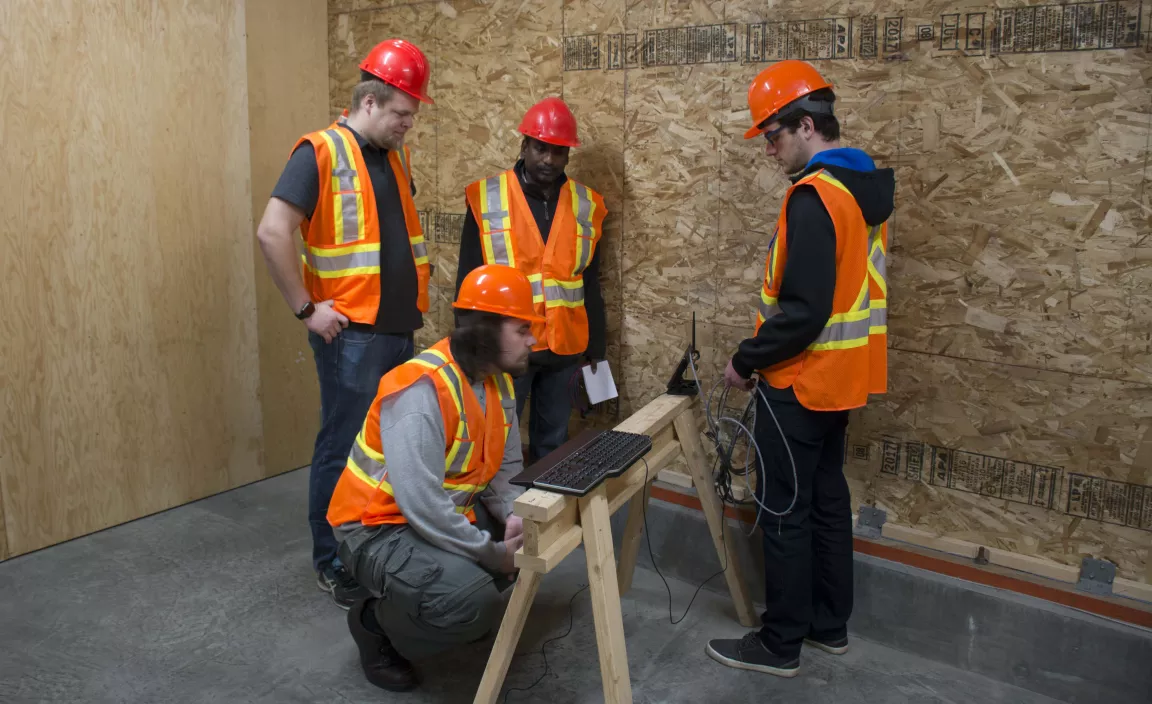A Lab in a Lab: Wood Innovation Research Lab as a Teaching Tool

The Wood Innovations Research Laboratory (WIRL) was still on the drawing board two years ago when it was first used as a teaching tool for University of Northern British Columbia students.
Throughout the design and construction phases, students provided their expertise to enhance the building and developed innovative solutions to some of the complex challenges of building North America’s first industrial-style building to Passive House standards. Students in the Master of Engineering in Integrated Wood Design program used the building as a case study, while Computer Science researchers developed a sensor system that will assist in the long-term study of the building’s Passive House performance.
“The construction of the lab next door to our classroom also allowed myself, and the other students, a first-hand glimpse into the construction of a building which employed the very principles of what we were learning every day,” says Alison Conroy, a student in the 2017 Master of Engineering cohort. “My research helped prepare me for my career by introducing me to local agencies and companies who had similar interest and needs for building science professionals due to growing market and regulatory demand for high performance buildings.”
The first cohort, in 2016, examined the feasibility of the project and produced reports looking at the proposed main layout of the building and its structural load. The second group identified issues around the sizes of beams required and other specific structural elements.
“Essentially, they came up with the same concept we used for the building,” says Master of Engineering in Integrated Wood Design program chair Dr. Guido Wimmers. “The students’ work matched what the professional architects and engineers came up with.”
One of the most visible student-led features is the acoustic improvement designed by the 2018 Master of Engineering cohort. The over-height lab is a very large open space and when saws and other pieces of heavy equipment are in use it can get quite loud.
As part of their acoustics class in February, the students were tasked with coming up with ideas on how to solve this challenge as traditional absorbers could not be used due to concerns around dust accumulation.
“The students came up with an interesting approach,” Wimmers explains. “We installed reflectors near ground level to reflect the sound waves upward, and we will hang baffles in the ceiling to reduce the reverberation by more than 50 per cent. It’s not going to be a concert hall but it will be much improved and much more comfortable for the researchers and technicians.”
Wimmers and Computer Science Professor Dr. Alex Aravind also teamed up to study the building’s Passive House performance. Along with graduate student Conan Veitch and undergraduate student Rodrigo Nicoletti Santoro Silverio, the team designed, tested and developed a prototype sensor system to measure the temperature and humidity in the building. They worked closely with Master of Engineering graduate Stephanie Wall and engineering technician Ryan Stern.
“This is a wonderful opportunity for students to get involved in interdisciplinary research,” Aravind says.
For Veitch and Silverio, the project gave them the chance to use the knowledge the learned in the classroom and in their research into a real-life application.
“This was an excellent experience as an undergraduate student,” Silverio says. “It was different from an academic project, because we knew the sensors were being installed in the building we had to dedicate enough time to properly test them to ensure they would work in real-world conditions.”
Veitch says it’s just one example of the many opportunities that exist for UNBC Computer Science students to get involved in research projects with our UNBC departments or other third-party groups.
“If you want to work on a project as an undergraduate computer science student at UNBC, you can,” he says. “Rodrigo and I can now put on our CV that we designed and constructed a sensor system for a university building from the ground up.”
Aravind says the next step in the research is to develop a software system to connect the sensors with the buildings heating and cooling systems to further maximize the lab’s energy efficiency.
“This could help the lab optimize its energy usage,” Aravind says. “Once we test this building, this type of sensor system could be replicated in many other buildings.”
Aravind, Wimmers and the students are working on an academic paper to share the insights they learned developing the sensor system project.
Now that it’s complete, the lab will be used extensively by researchers designing the next generation of tall wood buildings. Students will also be active in the facility, both as a lab to test their own design ideas and to learn how the lab equipment, like the CNC machine and robots work.
“We want to train our students to fully understand the capability and limitations of those machines because as engineers it will influence their design ideas,” Wimmers says.